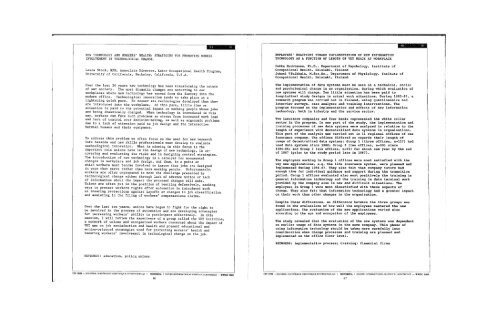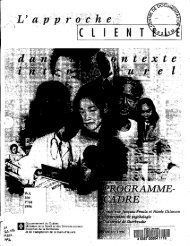le travail à l'écran de visualisation work with display units
le travail à l'écran de visualisation work with display units
le travail à l'écran de visualisation work with display units
You also want an ePaper? Increase the reach of your titles
YUMPU automatically turns print PDFs into web optimized ePapers that Google loves.
NEW TECHNOLOGY AND WORKERS' HEALTH: STRATEGIES FOR PROMOTING WORKERINVOLVEMENT IN TECHNOLOGICAL CHANGE.Laura Stock, MPH, Associate Director, Labor Occupational Health Program,University of California, Berke<strong>le</strong>y, California, U.S.A.Over the last 20 years new technology has been transforming the natureof our society. The most dramatic changes are occurring in our<strong>work</strong>places where new technology has spread from the factory into themo<strong>de</strong>rn office. Technological innovation tends to take place at alightening quick pace. No sooner are technologies <strong>de</strong>veloped than theyare introduced into the <strong>work</strong>place. At this pace, litt<strong>le</strong> time orattention is paid to the potential impact on <strong>work</strong>ing peop<strong>le</strong> whose jobsare being drastically changed. When technology is introduced in thisway, <strong>work</strong>ers can face such prob<strong>le</strong>ms as stress from increased <strong>work</strong> loadand lack of control over <strong>de</strong>cision-making, as well as ergonomie prob<strong>le</strong>msdue to a lack of attention paid to job <strong>de</strong>sign and the interactionbetween humans and their equipment.To address this prob<strong>le</strong>m we often focus on the need for new researchinto hazards and new skills professionals must <strong>de</strong>velop to evaluatetechnological innovation. What is missing in this focus is theimportant ro<strong>le</strong> unions have in the <strong>de</strong>sign of new technology, in uncoveringand evaluating its risks and in <strong>de</strong>signing control strategies.The introduction of new technology is a catalyst for monumentalchanges in <strong>work</strong>place and job <strong>de</strong>sign, and thus, is a point .atwhich <strong>work</strong>ers must become involved to insure that jobs are <strong>de</strong>signedin ways that serve rather than harm <strong>work</strong>ing peop<strong>le</strong>. Unfortunately,<strong>work</strong>ers are often unprepared to meet the chal<strong>le</strong>nge presented bytechnological change either through lack of advance notice or lackof information about the impact the proposed changes will make.Unions are often put in the position of reacting <strong>de</strong>fensively, seekingways to protect <strong>work</strong>ers rights after automation is introduced suchas insuring protections against layoffs or changes in job classificationand assisting in the filing of <strong>work</strong>ers' compensations claims.Over the last ten years, unions have begun to fight for the right tobe involved in the process of automation and are <strong>de</strong>veloping strategiesfor increasing <strong>work</strong>ers' ability to participate effectively. In thissession, I will review the experience of a group cal<strong>le</strong>d the VDT Coalition,a net<strong>work</strong> of unions and unorganized <strong>work</strong>ers concerned about the impact ofVDT use on job satisfaction and health and present educational andaction-oriented strategies used for protecting <strong>work</strong>ers' health andinsuring <strong>work</strong>ers' involvement in technological change on the job.EMPLOYEES' REACTIONS TOWARD IMPLEMENTATION OF NEW INFORMATIONTECHNOLOGY AS A FUNCTION OF LENGTH OF VDT USAGE AT WORKPLACEPekka Huuhtanen, Ph.D., Department of Psychology, Institute ofOccupational Health, Helsinki, FinlandJuhani Vitikkala, M.Sos.Sc., Department of Physiology, Insitute ofOccupational Health, Helsinki, FinlandThe imp<strong>le</strong>mentation of data systems must be seen as a technical, socialand psychological change in an organization, during which evaluation ofnew systems will change. Too litt<strong>le</strong> attention has been paid tolongitudinal study <strong>de</strong>signs in actual <strong>work</strong> situations. During 1985-87, aresearch program was carried out in Finland, using questionnaire andinterview surveys, case analyses and training interventions. Theprogram focused on the imp<strong>le</strong>mentation and effects of new informationtechnology, both in industry and the service sector.Two insurance companies and four banks represented the white collarsector in the program. In one part of the study, the imp<strong>le</strong>mentation andtraining processes of new data systems were analyzed in relation to the<strong>le</strong>ngth of experience <strong>with</strong> <strong>de</strong>centralized data systems in organizations.This part of the analysis was carried out in 11 regional offices of oneinsurance company. The offices differed as regards their <strong>le</strong>ngth ofusage of <strong>de</strong>centralized data systems: Group 1 (three offices, n=137) hadused data systems since 1982; Group 2 (two offices, n=90) since1984-85; and Group 3 (six offices, n=35) for about one year by the endof 1987 (prior to the study period late in 1987).The employees <strong>work</strong>ing in Group 1 offices were most satisfied <strong>with</strong> theway new applications, e.g. the life insurance system, were planned andimp<strong>le</strong>mented during 1986-87. They also felt that company tutors ha<strong>de</strong>nough time for individual guidance and support during the transitionperiod. Group 1 offices evaluated also most positively, the training ingeneral information technology and the training in data terminal <strong>work</strong>provi<strong>de</strong>d by the company also in new and difficult situations. Theemployees in Group 3 were most dissatisfied <strong>with</strong> these aspects ofchange. They also felt that information technology had a greater impacton their <strong>work</strong> than other changes in the organization.Despite these differences, no difference between the three groups wasfound in the evaluations of how well the employees mastered the newapplications. The evaluation of the new applications varied alsoaccording to the age and occupation of the employees.The study revea<strong>le</strong>d that the evaluation of the new systems was <strong>de</strong>pen<strong>de</strong>nton earlier usage of data systems in the same company. This phase ofusing information technology should be taken more carefully intoconsi<strong>de</strong>ration when change processes and training are planned andimp<strong>le</strong>mented on the office floor <strong>le</strong>vel.KEYWORDS: imp<strong>le</strong>mentation process; training; financial firmsKEYWORDS: education, policy, unionsTEV 12 1989 — DEUXIÈME CONFÉRENCE SCIENTIFIQUE.INTERNATIONALE • MONTRÉAL • SECOND INTERNATIONAL SCIENTIFIC CONFERENCE — WWDU 1989TEV 13 1989 — DEUXIÈME CONFÉRENCE SCIENTIFIQUE INTERNATIONALE • MONTRÉAL • SECOND INTERNATIONAL SCIENTIFIC CONFERENCE — "WWDU 1989
















